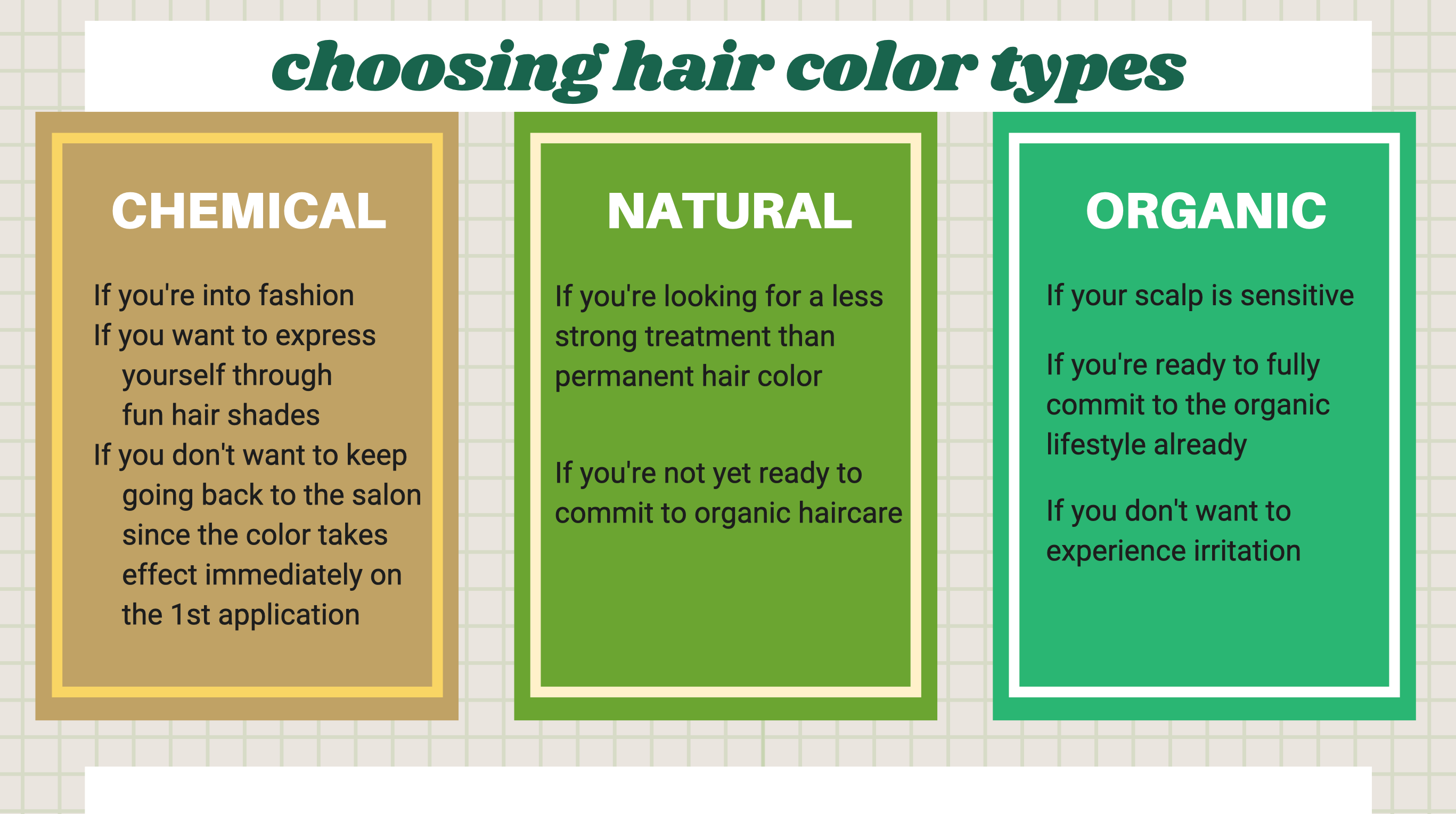Hair color is one of the most popular cosmetic products in the Philippines. Currently, there are different types of hair color now in the market. For this blog, let’s dig out the differences among the three hair dye types – chemical, natural and organic hair dye – and the ingredients that are a common concern for us all. Plus, we’ll include a simple guide on how to choose your hair color type at this phase of your life.
Know the Difference Among Chemical, Natural, & Organic Hair Color
QUICK RUNTHROUGH



CHEMICAL INGREDIENTS
Meanwhile, for chemical ingredient content like PPDs, take a look at this table shows the differences of the three:
Hair Color Type | Dye Type | Hydrogen Peroxide | Ammonia | ParaPenyleneDiamine |
|---|---|---|---|---|
| Chemical | Permanent (oxidizing) | YES | YES | YES |
| Natural | Permanent or Semi-Permanent | YES | YES | MAYBE |
| Organic | Semi-Permanent | NO | NO | NO |
PROCESS
How does chemical hair color work?
Chemical hair colors produce permanent hair color, and it works from the inside of the hair shaft to change the color from within. One of the ingredients that opens up the hair’s cuticle and lifts the hair’s natural pigment is ammonia, depositing the new pigment with the help of hydrogen peroxide, which causes the natural hair color to lighten. This is why it’s possible for dark-haired people to change their hair color to blondes and reds. There are more choices when it comes to chemical hair colors. See the photo below to see how chemical hair color works into the hair shaft.

- Tiny color molecules enter the cortex through an open cuticle layer.
- A series of chemical reactions happens inside the cortex. An oxidant process takes place with the help of hydrogen peroxide, which causes natural hair color to lighten and the dye molecules to swell up.
- The swollen color molecules join and remain in the cortex, making it impossible to escape.
How does natural hair color work?
To develop hair dyes without the harmful ingredients, researchers looked for more safer ingredients that can still color hair. These products may contain both natural ingredients and chemicals known to be less harsh on the hair scalp, and it’s called natural hair dye.
Also, it can be classified as permanent or semi-permanent hair color depending on the ingredients. Compared to organic hair color, the color should last longer before completely fading out. It can also go a little lighter, because it may have a small amount of hydrogen peroxide, and it can also penetrate and let a small amount of color into the cortex, depending on the amount of peroxide or ammonia in the hair color. See the photo below to see how natural hair color works into the hair shaft.

- Color molecules are larger than those of permanent hair color molecules.
- Only a small amount of color gets to the cortex, depending on the amount of peroxide or ammonia in the hair color.
- Most of the color stays on the cuticle and cannot penetrate inside.
How does organic hair color work?
Organic hair dyes, also called semi-permanent hair color, contains organic ingredients. (Please note that it may also not be a hundred percent organic; some ingredients may only be natural. Certifying bodies have their own standards and policies when it comes to calling a product organic.)
Organic hair dye colors the outside layer of the hair shaft only, and it needs more time and multiple applications to color and cover the gray hair. It doesn’t contain chemicals like PPD, ammonia, hydrogen peroxide, and resorcinol, so it doesn’t irritate the scalp. Moreover, it doesn’t contain any bleaching ingredients that can lighten the hair. So for Filipinos who have naturally dark hair, achieving a blonde shade is impossible with organic hair dye. See the photo below to see how organic hair color works into the hair shaft.

- Color molecules are larger than the color molecules of permanent and some semi-permanent hair colors.
- Molecules are too large to enter the cortex.
- These color molecules attach themselves to the cuticle and between the cuticle layers.
Though having the same objective – which is ultimately to color the hair – the main differences are down to these things: 1) ingredients; 2) way of covering the hair shaft; 3) number of applications needed to achieve the hair color; and 4) color choices.
SO HOW DO I CHOOSE?

Now, how do you choose the hair color for you? It depends on your needs and preferences.
For some who don’t want to go back to the salon every now and then (or to color their hair DIY in frequent intervals), chemical hair color may still be the most convenient choice for them. This type can also achieve the more unconventional and fun shades in the spectrum.
For some who have allergies to certain ingredients in permanent but would also like less time in applying and achieving their desired shade, they might choose natural.
For those who are very sensitive or allergic to the strong ingredients in permanent and would be willing to inve st time on coloring their hair regularly, organic hair color may be the one for them. When they’re ready to commit too to living an organic lifestyle, organic hair color may be a good place to start.
Just a tip: before making an investment, always weigh the pros and cons, for each type has its own. At the end of the day, we all have various concerns, conditions, and lifestyles – you alone will know what you need at this time of your life.

